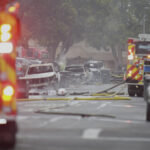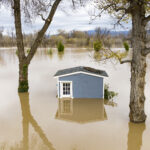Connecticut towns must learn to work together before the first warning is issued of an impending disaster or even before prevention plans are made, local officials were told this week.
It’s not an easy task in a state of 169 municipalities, a state emergency management official said at a forum organized to foster statewide action in the event of manmade and natural disasters.
“The concept of regionalization is the hardest part,” Wayne Sandford, deputy commissioner of the state Department of Emergency Management and Homeland Security, said after a presentation at the Connecticut Emergency Management Symposium.
“Every town is very independent,” he said at the event, which drew about 650 people. “We’re trying to get Connecticut to work together.”
Initially prompted by the terrorist attacks of Sept. 11, 2001, and reinforced by Hurricane Katrina in 2005, Connecticut and other states are learning to coordinate numerous actions ranging from organizing medical response teams to rescuing family pets.
In Connecticut, where towns historically have been autonomous, disaster preparedness means acting regionally. State officials have organized five regions based on population in an effort to improve disaster preparedness.
To a certain extent, the regional approach is required to compete for federal money also being sought by huge municipalities throughout the United States, Sandford said.
“There’s not one community in Connecticut that can hold a candle to Miami-Dade in Florida or New York City,” he said.
Sandford said state officials want the regional plan to be operational by June 2008, the start of next year’s hurricane season.
Regions will receive mobile hospitals, mass casualty trailers and other resources.
The regional plan is one of many being organized as Connecticut establishes disaster preparedness programs.
Greenwich has had an emergency management plan since World War II and updates it periodically. “We’ve been in this for a pretty long time,” said Dan Warzoha, the town’s emergency management director.
“Whatever happens in New York City has a ripple effect,” he said, citing the Sept. 11 attacks and anthrax found at NBC offices.
Most recently, Greenwich had to cope with last month’s flooding, which Warzoha said was the worst in decades.
Statewide emergency plans also include the Citizen Corps, a group of volunteers organized to work in a disaster. It has already trained 1,800 people, with an additional 1,000 to be trained, said William Austin, West Hartford’s fire chief and chairman of the Citizen Corps Council.
The intent of the program, a federal government initiative, “is to get citizens involved in their own defense,” he said.
Volunteers account for workers entering and leaving disaster sites, translate foreign languages or even provide entertainment for rescue workers, Austin said.
Was this article valuable?
Here are more articles you may enjoy.

 Will Workers’ Comp Benefit from ‘Most-Favored-Nation’ Drug Pricing?
Will Workers’ Comp Benefit from ‘Most-Favored-Nation’ Drug Pricing?  Plane Crashes into San Diego Neighborhood, Setting Homes And Vehicles on Fire
Plane Crashes into San Diego Neighborhood, Setting Homes And Vehicles on Fire  Report Shows Cargo Theft Risk at All-Time Highs as Memorial Day Weekend Nears
Report Shows Cargo Theft Risk at All-Time Highs as Memorial Day Weekend Nears  When a Neighborhood Floods, Foreclosures Often Follow
When a Neighborhood Floods, Foreclosures Often Follow 